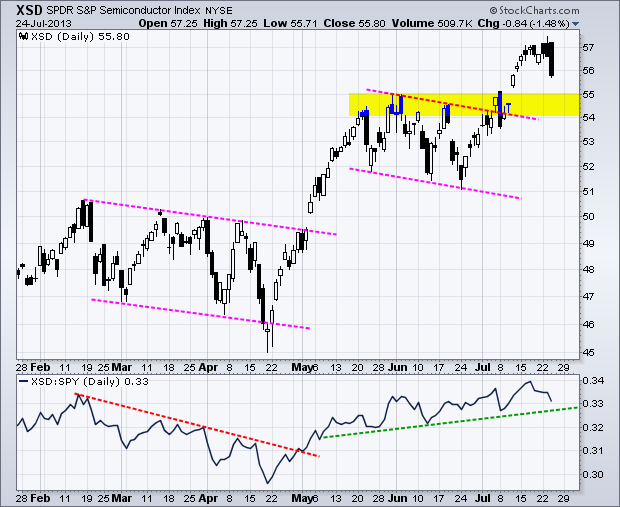Stocks were mostly lower on Wednesday with small-caps leading the way. The Russell 2000 ETF (IWM) lost around .83% and the S&P 500 ETF (SPY) lost around .37%. Techs were mixed with the Nasdaq 100 ETF (QQQ) adding .32% and the Nasdaq 100 Equal-Weight ETF (QQEW) losing .63%. QQQ was, of course, helped by Apple, which surged after beating on earnings and revenues. Expectations could ramp for Apple as the company hints at a busy fall refresh. The energy, materials and utilities sectors led the market lower. Even though new homes sales beat expectations and hit a five year high, homebuilders were down with the Home Construction iShares (ITB) falling almost 3%. ITB may, however, bounce today because Ryland (RYL) reported strong results after the close. Semiconductor stocks got hit hard as the Semiconductor SPDR (XSD) fell 1.5% and formed a long black candlestick. As with most index, sector and industry group ETFs, the long-term and short-term trends are up for XSD, but the ETF got a little overextended after a 10+ percent surge (51 to 57). Broken resistance in the 54-55 area turns first support.





**************************************************************************

**************************************************************************

**************************************************************************

**************************************************************************

**************************************************************************
Key Reports and Events (all times Eastern):
Thu - Jul 25 - 08:30 - Continuing Claims
Thu - Jul 25 - 08:30 - Durable Orders
Thu - Jul 25 - 10:30 - Natural Gas Inventories
Fri - Jul 26 - 09:55 - Michigan Sentiment - Final
Charts of Interest: Tuesday and Thursday
This commentary and charts-of-interest are designed to stimulate thinking. This analysis is
not a recommendation to buy, sell, hold or sell short any security (stock ETF or otherwise).
We all need to think for ourselves when it comes to trading our own accounts. First, it is
the only way to really learn. Second, we are the only ones responsible for our decisions.
Think of these charts as food for further analysis. Before making a trade, it is important
to have a plan. Plan the trade and trade the plan. Among other things, this includes setting
a trigger level, a target area and a stop-loss level. It is also important to plan for three
possible price movements: advance, decline or sideways. Have a plan for all three scenarios
BEFORE making the trade. Consider possible holding times. And finally, look at overall market
conditions and sector/industry performance.

About the author:
Arthur Hill, CMT, is the Chief Technical Strategist at TrendInvestorPro.com. Focusing predominantly on US equities and ETFs, his systematic approach of identifying trend, finding signals within the trend, and setting key price levels has made him an esteemed market technician. Arthur has written articles for numerous financial publications including Barrons and Stocks & Commodities Magazine. In addition to his Chartered Market Technician (CMT) designation, he holds an MBA from the Cass Business School at City University in London.
Learn More





